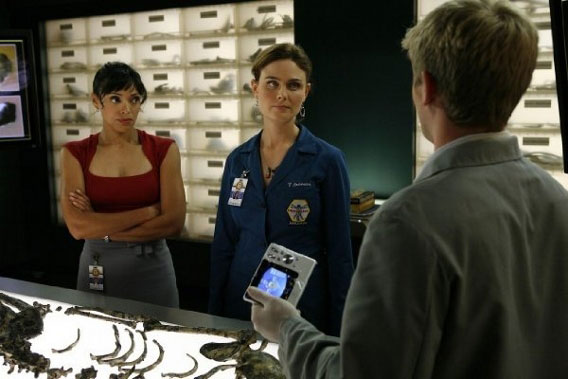Lessons in Black and White
Nonverbal communication of racial bias on popular TV shows can influence viewers’ bias, researchers say
Is racial bias contagious? A new study suggests that it is and that it is being spread subtly in popular culture.
In a series of experiments, Tufts psychology researchers found that characters in popular television shows were judged as more negative in their nonverbal behavior, such as body movement and facial expressions, toward black characters than white characters, even in positive situations. Those same negative associations were transmitted to viewers, who showed greater bias against blacks after watching the video clips.

The characters Camille Saroyan (played by Tamara Taylor), left, and Temperance Brennan (Emily Deschanel) from the show Bones. Photo: Courtesy of Fox
“The takeaway message is that bias can be contagious and can be transmitted through nonverbal behavior,” says Max Weisbuch, a postdoctoral fellow in the psychology department at the School of Arts and Sciences and lead author of the study, which was published in the journal Science.
The researchers hypothesized that nonverbal behavior, such as facial expressions and body language directed toward certain social groups, “might rub off on people who observe those sorts of patterns,” Weisbuch says.
Looking for a way to test their hypothesis, they decided to focus on popular television shows that featured recurring black and white characters of equal status and likeability. The researchers settled on 11 shows, including Bones, House and Friday Night Lights. They took clips of shows and edited out the audio and the target characters being interacted with. For example, Alexx, the black medical examiner in CSI: Miami, was cropped out of her clips, so that only the other characters could be seen as they interacted with her.
Nonverbal behavior, which is what the experiments judged, constitutes more than whether a person is smiling or frowning. “There’s a lot of research to suggest that it’s the whole picture, all these cues together—what the mouth is doing, the eyebrows, our body, leaning in or away —that communicates meaning to observers,” Weisbuch says.
White undergraduate study participants then viewed the clips and, through a series of tests, rated the nonverbal behavior of the characters. “Compared with black characters, white characters elicited significantly more favorable nonverbal responses,” according to the study.
“We weren’t necessarily surprised that these patterns occur on TV,” says Weisbuch. “After all, they do occur in the laboratory. We were somewhat surprised that they appeared on these programs, because the producers of these shows clearly make an effort to create a sense of diversity. But really the more important finding for us was that being exposed to these patterns of nonverbal behavior actually influences viewers’ own biases.”
To discover this, the researchers, including Nalini Ambady, professor of psychology in the School of Arts and Sciences and a Neubauer Faculty Fellow, and postdoc Kristin Parker devised another experiment. They showed two sets of study participants silent video clips that had been previously judged as pro-black or pro-white, and then had them take an Implicit Association Test, measuring their innate levels of racial bias.
What the researchers found was striking: being exposed to the negative patterns of nonverbal behavior toward blacks increased viewers’ own biases, which was confirmed in self-reporting measures.
Another group of study participants was recruited to watch the silent videos to see if the reported bias in the silent videos was obvious. “Once they had finished watching all the clips, we simply asked who was treated better, white people or black people, and they couldn’t tell,” Weisbuch says. “It was difficult to impossible to consciously identify the patterns.”
“Our findings suggest that hidden patterns of televised nonverbal behavior do measurably influence bias among viewers, even though viewers may be unable to consciously report observing a pattern of bias,” says Ambady, who directs the Interpersonal Perception and Communication Laboratory.
“Nonverbal behavior that communicates favoritism of one race over another can be so subtle that even across a large number of exposures, perceivers are unable to consciously identify the nonverbal pattern,” according to the study. “Yet despite (or perhaps because of) this subtlety, exposure to nonverbal race bias may transmit race bias to perceivers.”
What can be done about this? Weisbuch says he and his colleagues are trying to identify how and why the nonverbal race bias occurs, and “find out if there are pathways by which people might be immune to these sorts of effects.”
Taylor McNeil can be reached at taylor.mcneil@tufts.edu.


